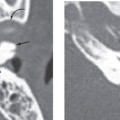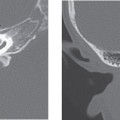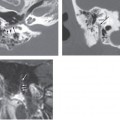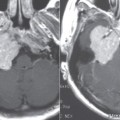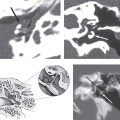CHAPTER 56 Lymphoma
Epidemiology
Middle ear malignant tumors are rare. The most common malignant tumors are squamous cell carcinoma and adenocarcinoma. Middle ear lymphoma is an extremely rare tumor with few cases reported in the literature. These include Hodgkin disease, B-cell non-Hodgkin lymphoma, and mycosis fungoides. Most of the cases occur as extension from temporal bone, which is affected in generalized lymphoma or as an extension from the nasopharynx. Primary malignant lymphoma of the middle ear was first described by Malik et al. Lymphoma of the middle ear may arise from the mucosa of the mastoid antrum, tympanum, or tympanic orifice of the eustachian tube, because these regions have a layer of lymphoid tissue deep to the epithelium that can be a primary site for lymphoma. It is also suggested that a small number of circulating lymphocytes home into areas that are usually not regarded as secondary lymphoid tissues.
Clinical Features
Clinical symptoms of middle ear lymphoma are nonspecific. Patients present with ear pain and varying degrees of conduction deafness and facial nerve palsy. Systemic manifestations of lymphoma in the form of fever, lethargy, and weight loss may be present. Some patients have enlarged neck lymph nodes. Initial ear presentation mimics infection; however, symptoms do not respond to medical therapy. Unresponsiveness to medical treatment and development of facial nerve paralysis should alert the clinician to suspect middle ear malignancy like lymphoma.
Pathology
Microscopic examination reveals tissue fragments of heterogeneous population of small degenerated cells, inflammatory cells, and medium to large atypical cells. The atypical cells demonstrate hyperchro-matic, convoluted, and clefted to absent amphophilic cytoplasm. Tumorlike necrosis can be also seen. Immunohistochemical staining (including pan-B and pan-T markers) demonstrates strong positive staining of atypical cells with leukocyte common antigen. For immunohistochemical examination, an unfixed specimen is preferable.
Treatment
Stay updated, free articles. Join our Telegram channel

Full access? Get Clinical Tree


